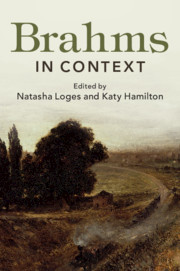Book contents
- Brahms in Context
- Brahms in Context
- Copyright page
- Dedication
- Contents
- Illustrations
- Music Examples
- Notes on Contributors
- Preface
- Abbreviations
- Part I Personality, People and Places
- Chapter 1 Childhood in Hamburg
- Chapter 2 The Schumanns
- Chapter 3 Vienna
- Chapter 4 Leipzig and Berlin
- Chapter 5 Personal Habits
- Chapter 6 Correspondence
- Chapter 7 Holidays
- Part II Identities, Environments and Influences
- Part III Performance and Publishing
- Part IV Society and Culture
- Part V Reception and Legacy
- Further Reading
- Index
- References
Chapter 6 - Correspondence
from Part I - Personality, People and Places
Published online by Cambridge University Press: 15 May 2019
- Brahms in Context
- Brahms in Context
- Copyright page
- Dedication
- Contents
- Illustrations
- Music Examples
- Notes on Contributors
- Preface
- Abbreviations
- Part I Personality, People and Places
- Chapter 1 Childhood in Hamburg
- Chapter 2 The Schumanns
- Chapter 3 Vienna
- Chapter 4 Leipzig and Berlin
- Chapter 5 Personal Habits
- Chapter 6 Correspondence
- Chapter 7 Holidays
- Part II Identities, Environments and Influences
- Part III Performance and Publishing
- Part IV Society and Culture
- Part V Reception and Legacy
- Further Reading
- Index
- References
Summary
In the nineteenth century, letters functioned as bridges between people. Brahms as a correspondent was part of many interconnected social webs; thus, his letters offer a view into this world. The vicissitudes of lifelong friendships, such as that with Joseph Joachim, can be traced seismographically through his greetings: from the romantic, rapturous letters of the twenty-year-old (‘Dear Friend of my heart!’, ‘Beloved Friend!’) to the ‘Dearest’ he used until 1863, the reserved ‘Dear Joachim’ after the crisis in the Joachims’ marriage (1883) or ‘Most honoured one’ (1886), until the restored intimacy of ‘Dear Friend’ (1894). Many of the composer’s letters, beyond the lifelong, established correspondents like Joachim or Clara Schumann, also trace the Brahms network. They are interwoven into a synchronous toing and froing of letters, for example in the early correspondence between all the Schumann friends: Brahms, Joachim, Grimm, Dietrich and so forth, which can be read in parallel.
Information
- Type
- Chapter
- Information
- Brahms in Context , pp. 52 - 59Publisher: Cambridge University PressPrint publication year: 2019
